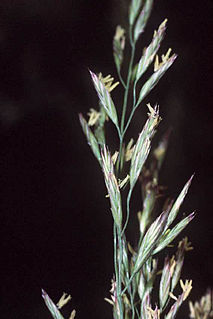
Festuca (fescue) is a genus of flowering plants belonging to the grass family Poaceae. They are evergreen or herbaceous perennial tufted grasses with a height range of 10–200 cm (4–79 in) and a cosmopolitan distribution, occurring on every continent except Antarctica. The genus is closely related to ryegrass (Lolium), and recent evidence from phylogenetic studies using DNA sequencing of plant mitochondrial DNA shows that the genus lacks monophyly. As a result, plant taxonomists have moved several species, including the forage grasses tall fescue and meadow fescue, from the genus Festuca into the genus Lolium, or alternatively into the segregate genus Schedonorus.
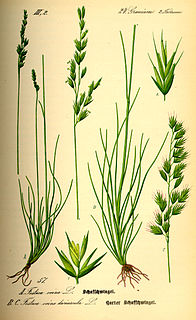
Festuca ovina, sheep's fescue or sheep fescue, is a species of grass. It is sometimes confused with hard fescue.

California coastal prairie, also known as northern coastal grassland, is a grassland plant community of California and Oregon in the temperate grasslands, savannas, and shrublands biome. It is found along the Pacific Coast, from as far south as Los Angeles in Southern California up into southern Oregon.
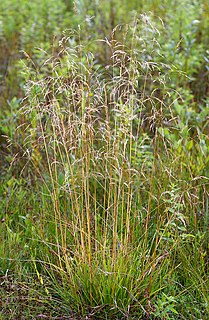
Deschampsia cespitosa, commonly known as tufted hairgrass or tussock grass, is a perennial tufted plant in the grass family Poaceae. Distribution of this species is widespread including the eastern and western coasts of North America, parts of South America, Eurasia and Australia.

Tragus, commonly called bur gras, burr grass or carrot-seed grass, is a genus of plants in the grass family. It is native to Africa, Australia, and Eurasia with several species on islands in the Atlantic, Indian, and Pacific Oceans plus one species in Argentina.

Festuca altaica, synonym Festuca scabrella, is a perennial bunchgrass with a wide native distribution in the Arctic, from central Asia to eastern North America. It has been called altai fescue and, under the synonym F. scabrella, rough fescue.

Anthyllis vulneraria, the common kidneyvetch, kidney vetch or woundwort is a medicinal plant native to Europe. The name vulneraria means "wound healer".

Festuca rubra is a species of grass known by the common name red fescue or creeping red fescue. It is widespread across much of the Northern Hemisphere and can tolerate many habitats and climates. It is best adapted to well-drained soils in cool, temperate climates; it prefers shadier areas and is often planted for its shade tolerance. Wild animals browse it, but it has not been important for domestic forage due to low productivity and palatability. It is also an ornamental plant for gardens.
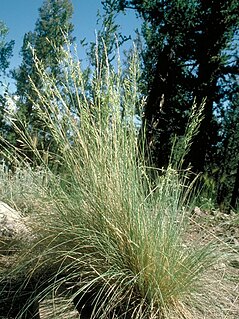
Festuca arizonica, commonly called Arizona fescue, is a grass found in western North America, in the southwest United States and northern Mexico. This species also has the common names mountain bunchgrass and pinegrass.

Festuca idahoensis is a species of grass known by the common names Idaho fescue and blue bunchgrass. It is native to western North America, where it is widespread and common. It can be found in many ecosystems, from shady forests to open plains grasslands.

Festuca viridula is a species of grass known by several common names, including green fescue, greenleaf fescue, and mountain bunchgrass. It is native to western North America from British Columbia to Colorado, where it is most abundant in high-elevation forests and meadows.
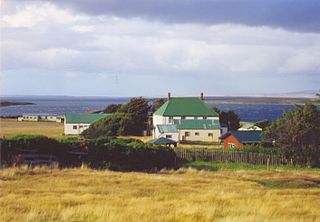
Tussock grasses or bunch grasses are a group of grass species in the family Poaceae. They usually grow as singular plants in clumps, tufts, hummocks, or bunches, rather than forming a sod or lawn, in meadows, grasslands, and prairies. As perennial plants, most species live more than one season. Tussock grasses are often found as forage in pastures and ornamental grasses in gardens.
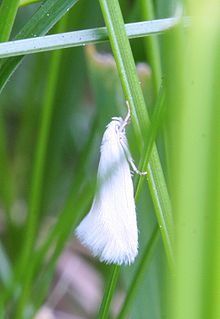
Elachista argentella is a moth of the family Elachistidae found in all of Europe, except the Balkan Peninsula.

Potentilla diversifolia or Potentilla × diversifolia is a species of flowering plant in the Rose Family (Rosaceae) known by the common names varileaf cinquefoil, different-leaved cinquefoil, and mountain meadow cinquefoil.

Festuca vivipara, the viviparous sheep's-fescue, is a species of grass native to northern Europe, northern Asia, and subarctic North America. The specific epithet vivipara is Latin, referring to the florets' alteration to leafy tufts. The plant can have a diploid number of 28, 49, 56, or 63, though numbers of 21, 35, and 42 have also been reported.

Festuca octoflora, also called six-weeks fescue, pullout grass, sixweeks fescue, eight-flower sixweeks grass, eight-flowered fescue; is an annual plant in the grass family (Poaceae). The common name "six week fescue" is because it supplies about 6 weeks of cattle forage after a rain.
Festuca edlundiae, commonly known as Edlund's fescue, is a native, perennial tufted grass found in Alaska, Canadian arctic islands, northern Greenland, far eastern arctic Russia and Svalbard. The specific name honours Doctor Sylvia Edlund, a Canadian botanist. It was first described by Susan Aiken, Laurie Consaul and Leonard Lefkovitch in 1995.
Margot Bernice Forde was a New Zealand botanist, curator, and taxonomist.

Festuca brachyphylla, the alpine fescue, is a grass native to Eurasia, North America, and the Arctic. The grass is used for erosion control and revegetation. The specific epithet brachyphylla means "short-leaved". The grass has a diploid number of 28, 42, or 44.
Festuca groenlandica, commonly known as the Greenland fescue, is a species of grass in the Festuca genus and Poaceae family. It is endemic to Greenland. The Flora of North America accepts this species. Other sources regard it as a synonym of Festuca brachyphylla.

















